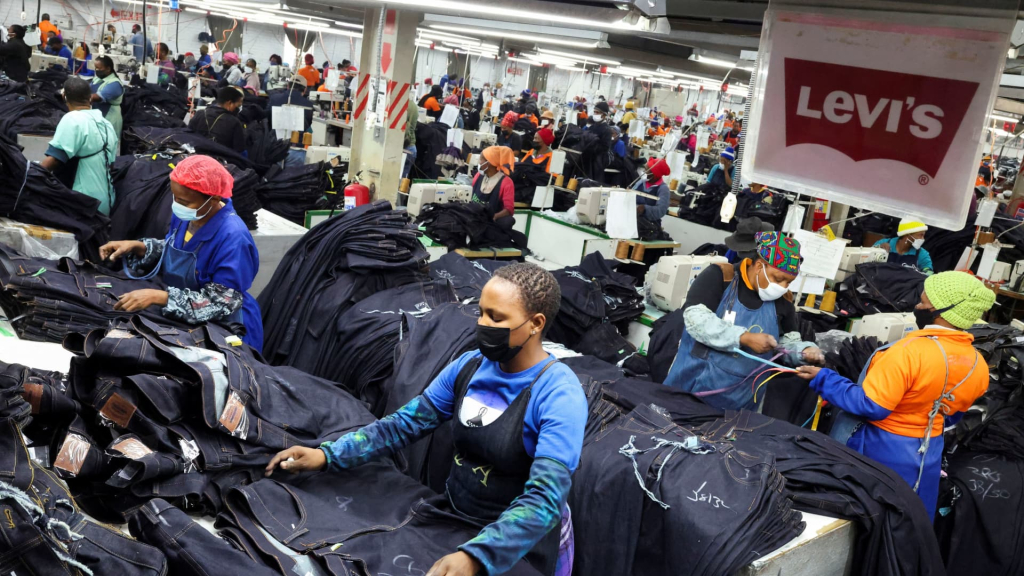Levi Strauss announced an upward revision of its full-year earnings guidance on Thursday, indicating that it is strategizing to mitigate the financial impact of increased tariffs. However, the company acknowledged that changes in President Donald Trump’s trade policies could alter this approach.
The denim giant does not publicly specify its primary manufacturing locations, but a significant portion of its production is sourced from Southeast Asia, where countries have been targeted under Trump’s reciprocal tariff agenda.
The company now projects its adjusted earnings for the full year to range between $1.25 and $1.30 per share, a revision from the previous forecast of $1.20 to $1.25. This estimate also surpasses analysts’ expectations of $1.23, according to LSEG. This forecast is based on the assumption of a 30% tariff on Chinese goods—where Levi’s produces only about 1% of its merchandise—alongside a 10% tariff on imports from other countries, which may fluctuate as trade negotiations continue.
In a conversation with Finance Newso, Levi’s Chief Financial Officer Harmit Singh stated that the bulk of the company’s sourcing is from nations such as Pakistan, Bangladesh, and Indonesia. Recent threats from Trump regarding duties exceeding 30% on Bangladesh and Indonesia add to the uncertainty, especially since 60% of Levi’s revenue is generated outside the U.S.
Currently, Levi’s plans to absorb as much of the tariff-related costs as possible, estimating a financial impact of approximately $25 million to $30 million—or 2 to 3 cents per share—for the remaining months of the year.
“We are doing our part by absorbing some of these costs. Our strong business performance has certainly aided this effort,” stated CEO Michelle Gass. “We’ve already scaled back on promotions, resulting in a higher rate of full-price sales. Our new product innovations are also positioned at premium prices, which consumers are embracing. These factors are facilitating our navigation through the current challenge of tariff impacts.”
Responding to an analyst’s inquiry about the decision to increase guidance amid economic uncertainties, Singh expressed confidence in sustained consumer spending patterns.
“With three quarters of high single-digit growth, we anticipate this momentum to persist, especially as the consumer base remains resilient and continues to favor our brand,” he noted.
In addition to addressing tariff implications, Levi’s recently reported fiscal second-quarter earnings that exceeded market expectations. The company’s performance metrics compared to analyst forecasts were as follows, based on LSEG polling:
- Earnings per share: Adjusted at 22 cents compared to an expected 13 cents
- Revenue: $1.45 billion versus an anticipated $1.37 billion
Following this announcement, Levi’s shares surged roughly 8% in after-hours trading. The reported net income for the quarter ending June 1 amounted to $67 million, or 17 cents per share, a marked increase from the previous year’s $18 million, or 4 cents per share. Excluding one-time charges related to restructuring, the company reported an earnings per share of 22 cents.
Sales for the quarter rose to $1.45 billion, reflecting a 6% increase from $1.36 billion in the same period last year.
In light of robust demand, Levi’s has amended its full-year revenue outlook, projecting sales growth between 1% and 2%, up from a prior forecast of a decline between 1% and 2%. This revised outlook stands in stark contrast to analysts’ predictions of a 5.2% revenue decline, according to LSEG.
However, the company has adjusted its gross margin expectations downward, anticipating a growth of 0.8 percentage points rather than previously forecasted due to tariff-related profit impacts.
For the upcoming quarter, Levi’s estimates sales growth of 3% to 4%, significantly better than the expected decline of 4.6%, with earnings per share projected between 28 and 30 cents, aligning closely with the anticipated figure of 30 cents.
Since Gass’s appointment as CEO, she has focused on divesting underperforming assets, such as the recent decision to sell the Dockers brand to Authentic Brands Group.
Gass has also prioritized direct consumer sales, enhancing the company’s e-commerce strategy and retail presence over traditional wholesale routes like Macy’s and Kohl’s. This shift is designed to improve margins and provide deeper insights into consumer preferences.
“Our operations reflect a strong commitment to a direct-to-consumer mindset,” Gass remarked during a call with analysts. “Our owned channels now account for over half of our business and continue to show healthy comp sales and improving profitability.”
While e-commerce can present challenges and complexity, Levi’s has achieved profitability in this area by leveraging scale to manage costs more effectively, Singh advised analysts.
The company’s gross margin reached a record 62.6% for the quarter, thanks to a reduction in markdowns, lower product costs, and an 11% growth in direct sales.
In its efforts to broaden its appeal, Levi’s is not only focusing on its historical male demographic but is also aiming to attract female shoppers and diversify its clothing range. During the recent quarter, revenue from women’s apparel rose by 14%, while sales of tops increased by 16%. Singh noted that the women’s segment is now the highest gross margin area for the retailer.
“Clearly, consumers are responding positively to this strategic direction. Despite the uncertainties in the broader market, we remain confident,” Gass told Finance Newso.
At the heart of Levi’s strategy is maintaining brand relevance amid evolving consumer preferences. Collaborative endeavors such as a partnership with Beyonce have kept the brand at the forefront of shoppers’ minds, especially during the singer’s Cowboy Carter tour. In May, Levi’s launched a limited-edition series of T-shirts co-created with Beyonce, marking the first product from this collaboration.
Additionally, a new partnership with Nike, which was introduced on Thursday, includes a collection featuring a denim-inspired version of the Air Max 95 available on Levi’s website and in select stores.

























